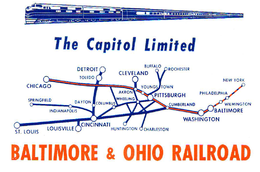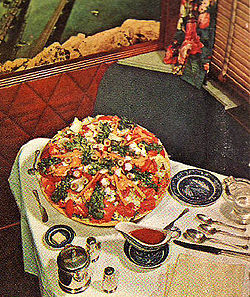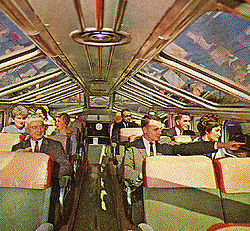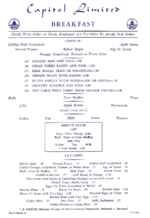.gif)
Capitol Limited (B&O)
Encyclopedia
.jpg)

The Capitol Limited was an American passenger train run by the Baltimore and Ohio Railroad
Baltimore and Ohio Railroad
The Baltimore and Ohio Railroad was one of the oldest railroads in the United States and the first common carrier railroad. It came into being mostly because the city of Baltimore wanted to compete with the newly constructed Erie Canal and another canal being proposed by Pennsylvania, which...
, originally between New York City
New York City
New York is the most populous city in the United States and the center of the New York Metropolitan Area, one of the most populous metropolitan areas in the world. New York exerts a significant impact upon global commerce, finance, media, art, fashion, research, technology, education, and...
and Grand Central Station
Grand Central Station (Chicago)
Grand Central Station was a passenger railroad terminal in downtown Chicago, Illinois, from 1890 to 1969. It was located at 201 W. Harrison Street in the south-western part of the Chicago Loop, the block bounded by Harrison Street, Wells Street, Polk Street and the Chicago River...
in Chicago, Illinois via Union Station, Washington, D. C. and Pittsburgh. For almost 48 years, it was the B&O's flagship passenger train, noted for personalized service and innovation. At the time of its discontinuation on May 1, 1971, when Amtrak
Amtrak
The National Railroad Passenger Corporation, doing business as Amtrak , is a government-owned corporation that was organized on May 1, 1971, to provide intercity passenger train service in the United States. "Amtrak" is a portmanteau of the words "America" and "track". It is headquartered at Union...
took over most rail passenger service in the U.S., the Capitol Limited operated between Washington and Chicago.
History
The Capitol Limited was inaugurated on May 12, 1923, as an all-Pullman sleeping carPullman (car or coach)
In the United States, Pullman was used to refer to railroad sleeping cars which were built and operated on most U.S. railroads by the Pullman Company from 1867 to December 31, 1968....
train running from Pennsylvania Station
Pennsylvania Station (New York City)
Pennsylvania Station—commonly known as Penn Station—is the major intercity train station and a major commuter rail hub in New York City. It is one of the busiest rail stations in the world, and a hub for inbound and outbound railroad traffic in New York City. The New York City Subway system also...
in New York City to Chicago, via Washington, D. C. Once west of the Hudson River in New Jersey the train used the Jersey Central
Central Railroad of New Jersey
The Central Railroad of New Jersey , commonly known as the Jersey Central Lines or CNJ, was a Class I railroad with origins in the 1830s, lasting until 1976 when it was absorbed into Conrail with the other bankrupt railroads of the Northeastern United States...
and Reading Railroad
Reading Company
The Reading Company , usually called the Reading Railroad, officially the Philadelphia and Reading Rail Road and then the Philadelphia and Reading Railway until 1924, operated in southeast Pennsylvania and neighboring states...
as far as Philadelphia, where it reached B&O's own rails to Chicago. It was designed to compete against the luxury trains of the rival Pennsylvania Railroad
Pennsylvania Railroad
The Pennsylvania Railroad was an American Class I railroad, founded in 1846. Commonly referred to as the "Pennsy", the PRR was headquartered in Philadelphia, Pennsylvania....
and New York Central Railroad
New York Central Railroad
The New York Central Railroad , known simply as the New York Central in its publicity, was a railroad operating in the Northeastern United States...
. Although the B&O's longer route put it at a competitive disadvantage in New York for time-sensitive travelers, the B&O offered such luxuries in the 1920s as onboard secretaries, barbers, manicures, and valets. The Capitol's "Martha Washington"-series dining cars were particularly noted for their Chesapeake Bay cuisine, served in ornate cars with leaded glass
Lead glass
Lead glass is a variety of glass in which lead replaces the calcium content of a typical potash glass. Lead glass contains typically 18–40 weight% lead oxide , while modern lead crystal, historically also known as flint glass due to the original silica source, contains a minimum of 24% PbO...
windows, glass chandeliers, and colonial-style furnishings. The Capitol Limited derived much of its passenger traffic from businessmen and government officials travelling between Washington and the midwest.
On September 1, 1926, the Pennsylvania Railroad terminated its contract with the B&O, which had permitted the latter to use the "Pennsy's" Hudson River tunnels and Pennsylvania Station in Manhattan. Thereafter, the Capitol Limited along with all other B&O passenger trains to New York, operated from the Jersey Central's Jersey City terminal, where passengers were then transferred to buses that met the train right on the platform. These buses were ferried across the Hudson River into Manhattan, where they proceeded to various "stations" including the Vanderbilt Hotel, Wanamaker's
Wanamaker's
Wanamaker's department store was the first department store in Philadelphia, Pennsylvania, and one of the first department stores in the United States. At its zenith in the early 20th century, there were two major Wanamaker department stores, one in Philadelphia and one in New York City at Broadway...
, Columbus Circle
Columbus Circle
Columbus Circle, named for Christopher Columbus, is a major landmark and point of attraction in the New York City borough of Manhattan, located at the intersection of Eighth Avenue, Broadway, Central Park South , and Central Park West, at the southwest corner of Central Park. It is the point from...
, and Rockefeller Center
Rockefeller Center
Rockefeller Center is a complex of 19 commercial buildings covering between 48th and 51st streets in New York City, United States. Built by the Rockefeller family, it is located in the center of Midtown Manhattan, spanning the area between Fifth Avenue and Sixth Avenue. It was declared a National...
, as well as Brooklyn.
In 1938, the B&O dieselized the train after purchasing two sets of the new EA and EB locomotives from General Motors' Electro Motive Corporation. The B&O was heavily in debt during the Depression
Great Depression
The Great Depression was a severe worldwide economic depression in the decade preceding World War II. The timing of the Great Depression varied across nations, but in most countries it started in about 1929 and lasted until the late 1930s or early 1940s...
and could not afford to buy new equipment, so it rebuilt its old heavyweight passenger cars into streamlined ones when the diesels were introduced in 1938, making the Capitol Limited the first dieselized streamlined train in the eastern U.S. By September, 1940, the through sleeping cars operating to New York were all streamlined. For the aesthetic features of the train the B&O turned to renowned industrial designer Otto Kuhler
Otto Kuhler
Otto Kuhler was an American designer, one of the best known industrial designers of the American railroads. According to Trains magazine he streamstyled more locomotives and railroad cars than Cret, Dreyfuss and Loewy combined...
who turned the Cap, as it was affectionately known, into a regal operation complete with a stunning royal blue, silver, and gold pin-striping livery (a paint scheme that would become one of the all-time classics of the streamliner era).
Route and equipment
Following the end of World War IIWorld War II
World War II, or the Second World War , was a global conflict lasting from 1939 to 1945, involving most of the world's nations—including all of the great powers—eventually forming two opposing military alliances: the Allies and the Axis...
, the B&O and the Santa Fe railway
Atchison, Topeka and Santa Fe Railway
The Atchison, Topeka and Santa Fe Railway , often abbreviated as Santa Fe, was one of the larger railroads in the United States. The company was first chartered in February 1859...
launched through sleeping car service between Washington, D.C. and Los Angeles on the Capitol Limited and the Santa Fe's Chief. In February, 1956, the Capitol Limited departed Jersey City at 12:45 p.m. as train # 5. As an express, all-Pullman sleeping car
Sleeping car
The sleeping car or sleeper is a railway/railroad passenger car that can accommodate all its passengers in beds of one kind or another, primarily for the purpose of making nighttime travel more restful. The first such cars saw sporadic use on American railroads in the 1830s and could be configured...
train, the Capitol Limited made limited stops along its 991 miles (1,594.9 km) route to Chicago. The following is a list of all station stops (major cities are highlighted in blue and Jersey City bus/ferry connections are in yellow):


| City | Departure time |
|---|---|
| New York (Rockefeller Center) | 11:50 a.m. |
| New York (Grand Central Terminal Grand Central Terminal Grand Central Terminal —often incorrectly called Grand Central Station, or shortened to simply Grand Central—is a terminal station at 42nd Street and Park Avenue in Midtown Manhattan in New York City, United States... ) |
12 noon |
| Brooklyn, NY | 12 noon |
| Jersey City, NJ | 12:45 p.m. |
| Wayne Junction, Pa. Wayne Junction (SEPTA station) Wayne Junction is a SEPTA Regional Rail station located at 4481 Wayne Avenue, extending along Windrim Avenue to Germantown Avenue, bordering the Nicetown and Germantown neighborhoods of Philadelphia, Pennsylvania.-Station:... |
2:10 p.m. |
| Philadelphia, Pa. | 2:30 p.m. |
| Chester, Pa. | 2:44 p.m. |
| Wilmington, Del. | 2:58 p.m. |
| Baltimore, Md. (Mt. Royal Station) Mount Royal Station The Mount Royal Station and Trainshed was the Baltimore and Ohio Railroad's third train station in Baltimore, Maryland, at the north end of the Baltimore Belt Line's Howard Street tunnel in the fashionable Bolton Hill neighborhood... |
4:12 p.m. |
| Baltimore, Md. (Camden Station) Camden Station Camden Station, now also referred to as Camden Yards, is a train station at the intersection of Howard and Camden Streets in Baltimore, Maryland, served by MARC commuter rail service and local Light Rail trains. It is adjacent to Oriole Park at Camden Yards... |
4:20 p.m. |
| Washington, D.C. (Union Station) Union Station (Washington, D.C.) Washington Union Station is a train station and leisure destination visited by 32 million people each year in the center of Washington, D.C. The train station is served by Amtrak, MARC and Virginia Railway Express commuter rail services as well as by Washington Metro subway trains and local buses... |
5:30 p.m. |
| Martinsburg, W. Va. Martinsburg (Amtrak station) Martinsburg Station is a railway station in Martinsburg, West Virginia, United States served by Amtrak and MARC. The station also included the historic Baltimore and Ohio Railroad roundhouse, and Martinsburg Shops.... |
6:57 p.m. |
| Cumberland, Md. Cumberland (Amtrak station) The Cumberland Amtrak station is a train station in Cumberland, Maryland, United States served by Amtrak, the national railroad passenger system. It is also served by Bayrunner Shuttle that starts in Grantsville and ends at BWI Airport... |
8:30 p.m. |
| Connellsville, Pa. | 10:44 p.m. |
| McKeesport, Pa. | 11:33 p.m. |
| Pittsburgh, Pa. | 12:08 a.m. |
| Garrett, Ind. | 5:00 a.m. (CT) |
| La Paz, Ind. | 5:56 a.m. |
| Gary, Ind. | 6:54 a.m. |
| South Chicago, Ill. | 7:15 a.m. |
| Chicago (63rd St.) | 7:32 a.m. |
| Chicago (Grand Central Station Grand Central Station (Chicago) Grand Central Station was a passenger railroad terminal in downtown Chicago, Illinois, from 1890 to 1969. It was located at 201 W. Harrison Street in the south-western part of the Chicago Loop, the block bounded by Harrison Street, Wells Street, Polk Street and the Chicago River... ) |
8:00 a.m. |
| source: Official Guide of the Railways Official Guide of the Railways The Official Guide of the Railways, now known as the Official Railway Guide, was originally produced by National Railway Publication Company of New York City, beginning in 1868... , February, 1956 |
|
Eastbound, the train departed Chicago at 4:30 p.m. as train # 6. This scheduled departure was timed so that travelers riding western railroads such as the Santa Fe
Atchison, Topeka and Santa Fe Railway
The Atchison, Topeka and Santa Fe Railway , often abbreviated as Santa Fe, was one of the larger railroads in the United States. The company was first chartered in February 1859...
, Chicago and North Western Railway
Chicago and North Western Railway
The Chicago and North Western Transportation Company was a Class I railroad in the Midwest United States. It was also known as the North Western. The railroad operated more than of track as of the turn of the 20th century, and over of track in seven states before retrenchment in the late 1970s...
, or the Burlington
Chicago, Burlington and Quincy Railroad
The Chicago, Burlington and Quincy Railroad was a railroad that operated in the Midwestern United States. Commonly referred to as the Burlington or as the Q, the Burlington Route served a large area, including extensive trackage in the states of Colorado, Illinois, Iowa, Kentucky, Missouri,...
could readily connect for an eastward journey on B&O's deluxe train. During the height of train travel in the 1920s, the Capitol Limited occasionally ran in multiple sections, although never as frequently or extensively as the competing Pennsylvania Railroad's Broadway Limited
Broadway Limited
The Broadway Limited was the Pennsylvania Railroad's premier named passenger train, operating daily in each direction between New York City and Chicago, via North Philadelphia. It replaced its predecessors, the Pennsylvania Limited and the Pennsylvania Special...
and New York Central Railroad
New York Central Railroad
The New York Central Railroad , known simply as the New York Central in its publicity, was a railroad operating in the Northeastern United States...
's 20th Century Limited
20th Century Limited
The 20th Century Limited was an express passenger train operated by the New York Central Railroad from 1902 to 1967, during which time it would become known as a "National Institution" and the "Most Famous Train in the World". In the year of its last run, The New York Times said that it "...was...
.
The B&O was the first railroad to introduce air conditioning
Air conditioning
An air conditioner is a home appliance, system, or mechanism designed to dehumidify and extract heat from an area. The cooling is done using a simple refrigeration cycle...
on its trains, beginning with the Columbian in 1931, followed by the Capitol Limited on May 22, 1932, well ahead of its competitors. This innovation received favorable comment nationwide by the news media.

Dining car
A dining car or restaurant carriage , also diner, is a railroad passenger car that serves meals in the manner of a full-service, sit-down restaurant....
, two dome car
Dome car
A dome car is a type of railway passenger car that has a glass dome on the top of the car where passengers can ride and see in all directions around the train. It also can include features of a coach, lounge car, dining car or observation...
s, club car, and a flat-end observation car
Observation car
An observation car/carriage/coach is a type of railroad passenger car, generally operated in a passenger train as the last carriage, with windows on the rear of the car for passengers' viewing pleasure...
.
The B&O re-equipped the Capitol Limited with new, streamlined
Streamliner
A streamliner is a vehicle incorporating streamlining in a shape providing reduced air resistance. The term is applied to high-speed railway trainsets of the 1930s to 1950s, and to their successor "bullet trains". Less commonly, the term is applied to fully faired recumbent bicycles...
sleeping cars in 1950 and 1954, including the new duplex-roomette type. The Pullmans were named after rivers and lakes along the train's route, such as "Cacapon"
Cacapon River
The Cacapon River , located in the Appalachian Mountains of West Virginia's Eastern Panhandle region, is an river known for its fishing, boating, wildlife, and scenery...
and "Wawasee"
Lake Wawasee
Lake Wawasee, formerly Turkey Lake, is a natural lake southeast of Syracuse in Kosciusko County, Indiana, United States. It is the largest natural lake in Indiana. It is located just east of Indiana State Road 13.-History:...
. Dome cars "Moonlight Dome" and "Starlight Dome", having sleeping compartments on their lower levels, were added on January 8, 1951. A twin-unit dining car seating 64 passengers at a time was obtained from the New York Central in 1957.
Decline and final run

To stem the loss of passengers and resulting deficits, the B&O in the early 1960s offered reduced mid-week fares, auto shipment for passengers (similar in concept to the Auto Train
Auto Train
Auto Train is an scheduled train service for passengers and their automobiles operated by Amtrak between Lorton, Virginia , and Sanford, Florida . Although there are similar services around the world, the Auto Train is the only one of its kind in the United States...
), and onboard movies, to attract more passengers. The train was marginally profitable, when mail and express revenue was included.
The loss in 1967 of mail and express contracts, which by then accounted for almost 70 percent of total passenger train revenue for the B&O, severely affected the B&O's passenger service. The Postal Service's cancellation of its mail contract for the Capitol Limited and other trains on October 28, 1967, was the death knell. Many passenger trains were dropped and the consist of the Capitol Limited was considerably reduced. B&O discontinued all long-distance train service to Baltimore's Camden Station. Between October, 1966, and April, 1971, a connecting RDC
Budd Rail Diesel Car
The Budd Rail Diesel Car, RDC or Buddliner is a self-propelled diesel multiple unit railcar. In the period 1949–62, 398 RDCs were built by the Budd Company of Philadelphia, Pennsylvania, United States...
operated between Baltimore and Washington, D.C., as train # 105. By June, 1969, two E diesel electric engines pulled a train of: 1 baggage, 1 sleeper (10/6), 1 diner / lounge, 1 dome coach, and four coaches.
With the advent of Amtrak
Amtrak
The National Railroad Passenger Corporation, doing business as Amtrak , is a government-owned corporation that was organized on May 1, 1971, to provide intercity passenger train service in the United States. "Amtrak" is a portmanteau of the words "America" and "track". It is headquartered at Union...
on May 1, 1971, the Capitol Limited was discontinued by the B&O, along with all of its other passenger trains (except for local commuter services). For the final run of the old Capitol Limited on April 29, 1971, the B&O ran the entire trainset from Baltimore's Camden Station, including the dome car. The B&O printed special commemorative tickets and returned its bottled Deer Park spring water
Deer Park Spring Water Co.
Deer Park Spring Water Co. is a company that produces natural spring water. It is a division of Nestlé and was established in 1873. The bottled water was originally primarily sold in the New York market, but now can be found along most of the East Coast....
and B&O's signature, "all-you-can-eat" giant salad bowls to the final run's dining car, some of the Capitol Limited 's amenities from more prosperous times. A 31-year veteran dining car waiter on the last run of the Capitol Limited recalled to a Baltimore Sun reporter that, "all the vegetables we served were freshly cooked on board — no frozen or canned food at all."
At its inception, Amtrak did not continue any of the B&O's former passenger train routes, and the Capitol Limited ended its 48-year run on the B&O. After a lapse of ten years, Amtrak revived Washington—Chicago service using the same B&O tracks (now CSX Transportation
CSX Transportation
CSX Transportation operates a Class I railroad in the United States known as the CSX Railroad. It is the main subsidiary of the CSX Corporation. The company is headquartered in Jacksonville, Florida, and owns approximately 21,000 route miles...
) between Washington and Pittsburgh, Pennsylvania
Pittsburgh, Pennsylvania
Pittsburgh is the second-largest city in the US Commonwealth of Pennsylvania and the county seat of Allegheny County. Regionally, it anchors the largest urban area of Appalachia and the Ohio River Valley, and nationally, it is the 22nd-largest urban area in the United States...
, for the Amtrak Capitol Limited.

Further reading
- Joe Welsh, Baltimore and Ohio's Capitol Limited and National Limited. Saint Paul, MN: Voyageur Press, MBI, 2007

